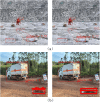WA-YOLO: An explosive material detection algorithm for blasting sites based on YOLOv8
- PMID: 40261946
- PMCID: PMC12013926
- DOI: 10.1371/journal.pone.0318172
WA-YOLO: An explosive material detection algorithm for blasting sites based on YOLOv8
Abstract
Pyrotechnic detection has always been one of the critical issues in blasting safety. Due to the complex environment of blasting sites, irregular detonator wire postures, and the differences in object scales, making the detection of pyrotechnics more challenging. To address these challenges, this paper proposes an improved algorithm based on a multi-scale parallel attention mechanism and wavelet-separable convolution, called WA-YOLO. First, we integrate wavelet convolution into depthwise separable convolution and propose a novel convolutional block (WSDConv, Wavelet Separable Depthwise Convolution). This new convolutional block is added to the model's backbone, improving feature extraction while also lowering computational parameters. Furthermore, we introduce an improved Cross Stage Partial (CSP) structure by combining multi-scale convolutions with a parallel attention mechanism, embedding it into the C2f module of the neck network to improve the model's ability to detect objects of varying scales in complex backgrounds. To tackle the detection accuracy drop caused by the irregular shapes and varying aspect ratios of detonator wires, the model uses the Wise-IoU loss function. This enhances the model's generalization and robustness by improving the precision of overlap calculations for bounding boxes. The experimental results show that the improved model achieved an average precision increase of 12.6% on the self-built dataset, particularly with an average precision increase of 8.3% in the detection of detonators. Additionally, the model performance also improved on the VOC2012 dataset, with a recall increase of 1.3% and an average precision increase of 1.6%. These results indicate that the proposed model exhibits strong generalization capabilities, can work effectively across different datasets, and provides an effective solution to the challenges of target detection in blasting environments.
Copyright: © 2025 Li et al. This is an open access article distributed under the terms of the Creative Commons Attribution License, which permits unrestricted use, distribution, and reproduction in any medium, provided the original author and source are credited.
Conflict of interest statement
The authors have declared that no competing interests exist.
Figures
















Similar articles
-
An object detection model AAPW-YOLO for UAV remote sensing images based on adaptive convolution and reconstructed feature fusion.Sci Rep. 2025 May 9;15(1):16214. doi: 10.1038/s41598-025-00239-4. Sci Rep. 2025. PMID: 40346071 Free PMC article.
-
BED-YOLO: An Enhanced YOLOv10n-Based Tomato Leaf Disease Detection Algorithm.Sensors (Basel). 2025 May 2;25(9):2882. doi: 10.3390/s25092882. Sensors (Basel). 2025. PMID: 40363318 Free PMC article.
-
An Improved YOLOv8-Based Method for Detecting Pests and Diseases on Cucumber Leaves in Natural Backgrounds.Sensors (Basel). 2025 Mar 2;25(5):1551. doi: 10.3390/s25051551. Sensors (Basel). 2025. PMID: 40096374 Free PMC article.
-
RFAG-YOLO: A Receptive Field Attention-Guided YOLO Network for Small-Object Detection in UAV Images.Sensors (Basel). 2025 Mar 30;25(7):2193. doi: 10.3390/s25072193. Sensors (Basel). 2025. PMID: 40218706 Free PMC article.
-
MGL-YOLO: A Lightweight Barcode Target Detection Algorithm.Sensors (Basel). 2024 Nov 27;24(23):7590. doi: 10.3390/s24237590. Sensors (Basel). 2024. PMID: 39686126 Free PMC article.
References
-
- Huang K, Chen X, Kang Y. A review of intelligent video surveillance technology. J Comput Res Dev. 2015;38(6):1093–118.
-
- Wang X, Wu C, Tao L. Intelligent blasting. Metallurgical Industry Press. 2020;39(3):120–35.
-
- Yang H. Research on intelligent real-time danger early warning method for open-pit mine blasting site based on improved YOLOv3. J Northeastern Univ. 2021;42(2):110–23.
-
- Zhang G, Liang E, Wei S, et al.. Research on helmet wearing detection algorithm based on YOLOv3 for blasting site. Internet Things Technol. 2022;12(4):90–6.
-
- Liu X, Yang H, Jing H. Research on intelligent risk early warning of open-pit blasting site based on deep learning. Energy Sources Part A Recovery Utilization and Environmental Effects. 2021;43(1):1–18.
MeSH terms
Substances
LinkOut - more resources
Full Text Sources

